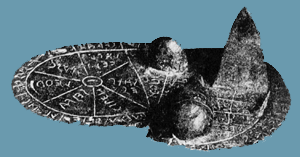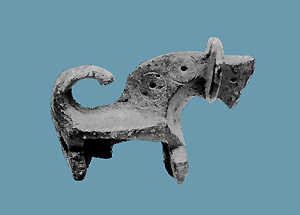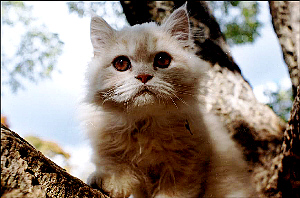Raivo Mänd
The society's worry about the well-being of pets, domestic, guard,
test and zoo animals has sharply risen in the past decades. The main
problems harming animals kept as pets are anthropocentrism and
anthropomorphism common among pet-owners. Although discussion about the
quality of life a pet-owner must provide for his pets is not finished, the
consensus is that an animal must be afforded as natural a lifestyle as
possible, has to be kept from enduring and strong negative emotions
(fear, pain, etc.), being offered at the same time a maximum of natural
pleasures and ensuring satisfactory health and growth as well as normal
functioning of physiological and behavioural systems. The article
introduces methods used for studying choices animals make.
Enn Ernits

Foretelling fate, course of disease, the weather, etc. has always been considered important. An important role in mantic lore has always been played by forecasts based on the bones and internal organs of the sacrificial animal or the pet of a deity. Based on the changes of the liver, less commonly heart and lungs of ruminants and other mammals, for example, the Etruscan haruspices foretold who is depicted on a gravure by means of a trachea, lungs and liver (4th c BC). Observation of the liver was probably studied with the help of models. In 1877, a bronze lamb liver was found in Italy featuring many details. The internal surface of the liver is divided into sectors dedicated to favourable and unfavourable deities. Etruscan methods of divination may originate from Ancient Orient. Professor of anatomy, Ludwig Stieda (1900) compared the Etruscan liver diagram with a Mesopotamian find a thousand years older. From there, the art of liver observation spread via the Hetites to Greece and Etruria. Before the cuneiform writing was deciphered, hints on Bablyonian hepatoscopy could be read in the Bible. Babylonian liver models resemble the Etruscan bronze liver. The Ninive library texts name more than a dozen liver-related terms. In the prostasis Babylonians considered the individual features and pathological changes of the liver. The more rare the change in the liver, the more weight the apodoses had.
Babylonians also studied the intestines of sheep, paying attention to the positioning of the organs. There are many records of different peoples using the liver and spleen of various domestic and wild animals to forecast weather. There are hundreds of ancient architectural objects, labyrinths composed of cobblestones in the northern countries that are considered to be a model of the intestines of the sacrificial animal, i.e. the colon of ruminants.
In ancient China, forecasts were based on mammalian bones and
the cracks of a turtle's shell. Wide popularity was enjoyed in earlier times
by omoplastoscopy or forecasting by the shoulder-blade (e.g. in
North America, Ireland, Siberia, Mongolia, China). The Khazakhs
distinguished at least seven subsections and a number of regions on a fire-heated
shoulder-blade, the cracks at angles forming in different regions
expressing various groups of omens.
Tõnno Jonuks

In the article I am going to give a concise overview of the relationship between dogs and people in the context of Estonian prehistory. The dog has been accompanying humans ever since the arrival of the first people on Estonian territory ca 9000 BC. Pendants made of dog teeth were in wide use during the Middle Neolithic. At the end of the Neolithic when all kinds of pendants disappeared, all signs of dogs disappeared as well. Throughout the Late Bronze Age till the end of the Roman Iron Age (1100-500 AD) dogs were placed into graves, although not often. Also, they are mostly represented by single bones. A new tradition began during the Migration Period, reaching its culmination in the Viking Age: now dogs were buried as a body, they were cremated on the funeral pyre with their masters. In addition, small bronze figurines were made depicting dogs. Some of these were used as pendants; some are just figures that would have been difficult to use as pendants (for example the figurine from Ehmja grave). The region's historians have discussed the connection of animals with the concept of the Otherworld relatively thoroughly. Still, the dog has not been the most popular animal in these studies. Several interpretations have been offered: the dog as the guard of the Otherworld or the grave, the dog as a warrior-dog, the dog as a sacrifice.
Considering that dog burials and figurines appear during the
Estonian Viking Age and the Late Iron Age, it seems that dog had
been connected with a new concept of the Otherworld that started to spread
in the Migration Age. According to this, the Otherworld existed as a
separate place that reflected the life in this world, although not one-to-one
but with a certain shift towards the ideal. This means that the
Otherworld expressed not the actual life but the model of what life should be
like. Considering the material of Estonian stone graves, there is good
reason to believe that it reflects only the burial sites of the elite and their
ideas of the Otherworld. A part of the Otherworld was probably made up
by celebrations and other elite amusements like hunting, a symbol of
which might have been a dog in the grave.
Maarja Kaaristo
Using parish court records as a source of study requires
understanding the history of the the parish court as an institution and the court
institutions for peasants of the Estonian region in general. The first
parish courts in Estonia were established in the late 18th century, and
generally were subject to change with the regulations of 1802 and the
peasant laws of 1804. The Livonian peasant law does not set punishment
for hitting, beating and violent handling of animals, thus injuring
animals was covered by crimes against property. I review plaints concerning
injury to domestic animals in the records of some South-Estonian
parish courts. These fall into two broad categories: complaints about beating
of and injury to domestic animals or killing or causing death of
domestic animals. There are more complaints about harming or beating.
Injuring or killing animals could be stiffly penalised.
Loone Ots
The first animal protection societies in the Baltic provinces of the Tsarist Russian Empire were established in the 1860s. Members were mostly Baltic Germans. Data on the first indigenous Estonian society dates from the 1890s. In the 1930s, the population of Estonia was 1,061,000 and the number of domestic animals was 2,516,500. Animals were protected by § 276 of the Criminal Code (`the ungrounded torturing of animals is punishable') and national law regulated hunting, slaughter and transport to slaughter-houses. Two counties and eleven towns established animal protection by-laws at local authority level.
In 1935, 22 animal protection societies were active in Estonia, with 4,500 adult members, and many young members; 18 societies belonged to the Estonian Union of Animal Protection Societies, founded in 1929. In 1935, the Union started to publish a periodical (planned as bi-monthly) `The Estonian Animal Protector'.
Most people had lived in towns for less than one generation, so attitudes were similar to those in the country. There were some differences to the countryside. Firstly, town animals were gratuitously tortured without reason and secondly, town people were more contemptuous of animals. Direct violence, such as the cutting out of a tongue of a cat, was also recorded in towns, but not in the countryside. This apparent difference of behaviour may be as a result of a lack of information about the situation of pets in the country.
In conclusion, in the 1930s, animal protection was respected and
successful in Estonia, and animal protection societies' members had
strong support from local authorities.
Renata Sõukand

The above proverb is found in the database of Estonian proverbs in
different variations 160 times, making this the second most widespread
proverb about cats and the fourth about dogs. The article outlines the
roots and background of this belief, viewing the behaviour of both
animals and their habits in co-existence with humans. This kind of differentiation between cat and dog is rather a reflection of people's
accustomed behaviour and expectations derived from the animal's behaviour -
both animals' mouths contain both pathogenic micro-organisms and
healing substances.
Maarja Villandi
In the present work I analyse stories told about pets in groups.
Stories about pets can be regarded as folklore because it is oral lore and
those stories can normally not be found in literary sources. They are based
on personal experiences or stories heard from other people. There are
three requirements for a situation which to be favourable for the storytellers:
- contact between two or more persons;
- the situation creates an atmosphere of storytelling;
- an interest in pets by at least one person.
Stories of pets mostly involve cats and dogs. The reason could be
that they are the most common pets. The stories I collected were mostly
told by adults but the difference between stories of adults and children
is small. It must also be mentioned that stories about pets are told in
groups of unfamiliar people because they are generally understandable
and popular. I made an attempt to categorise stories about pets and I
initially found seven kinds:
- stories of getting pets;
- stories of special skills and/or character of the pets and special cases concerning them;
- stories about relationships between pets;
- stories about pet food;
- stories about ignorant pet owners;
- stories about dangerous pets;
- stories about the disappearing or death of pets.
Stories about pets are a very popular form of communication. It is
often a short form and there are not many motives but there are also
many deviations of the standard. There are also Internet forums for
people who love pets and the existence of Internet folklore is not to be doubted.
Ell Vahtramäe
Names have several functions. The article concerns four of these -
the identifying, social, communicative and magical. The change in the
relationship in keeping animals, especially the trend from utility animal to pet
is also reflected in animal names. The overview concerns which
domestic animals were named, sources of inspiration for names, factors
determining choices, the way of writing names and way of calling pets. A
short insight into the naming ritual and courses of action in case an
animal has received a "wrong name" is provided. The material used is
divided provisionally into traditional and newer, the new reflecting recent
trends in animal naming. Recent naming traditions give cause to
differentiate rural and urban animal culture.
Ülo Siimets
The article reviews hunting styles and means among the Chukches
of the Chukotka Peninsula in 1971. For comparison, earlier descriptions
of hunts are provided. The Coastal Chukchshes hunt mainly marine
life. In the winter they also hunt rabbits, foxes, wolverines, polar foxes,
wolves and occasionally polar bears. The herder Chukches live away from
the coast and their game includes reindeer, snow sheep, brown bears,
rarely polar bears and naturally rabbits, foxes, wolverines, wolves.
Chukches specialising in hunting also catch squirrels, pine marten and
sables. Hunting was inseparable from rites such as the bear's feast,
deflecting evil spirits. The article contains ethnographic descriptions of classical
catching equipment.
Juhan Javoiš
In the present article, a pet is defined as an animal kept with humans
for the purpose of satisfying psychical needs. In this sense a pet is opposed
to other domestic animals that satisfy more direct needs: food,
hunting, guarding, catching mice, etc. Keeping pets has become massive only
recently and thus needs to be analysed. The phenomenon of pet-keeping
is discussed from both the point of view of humans and animals. A
person satisfies different needs by keeping pets: the rudimental need to
keep animals, the need to be close to nature, the parental instinct, the need
for subjugation, need for adventure, social needs. The criteria of animal
well-being is considered realisation of genetical predispositions in
everyday environment. Based on this, it must be said that as a rule the keeping
of animals not synanthropic as pets oppresses their well-being since
only the most primary of the animal's needs are satisfied. This may not
be noticed by the animal's keeper due to the communication barrier
between the human and animal, as well as because animals commonly "make
a good face to a bad game". If the keeping of an animal not synanthropic
is unavoidable, it is recommended to choose more intelligent, i.e. more
adaptable species. However, such species regularly require very expensive
care. If possible, synanthropic species should be preferred. The well-being of
a synanthropic animal as a pet may be maximal. Other animals could
effectively be observed in their natural habitat instead of in imprisonment.
Ülo Siimets
Everyone has encounters with animals, pets, birds or fish. These are
personal encounters that belong to him, his acquaintances, friends,
children. Usually having a pet has a sad ending since the lifespan of most pets
is markedly shorter than that of people. In the present work the
author reminiscent on the cats, dogs, duck, fish and other animals from his
childhood.
News, overviews
The doctoral thesis by Kärt Summatavet had the research part
published as a book Folk Tradition and Artistic Inspiration: A Woman's Life in
Traditional Estonian Jewelry and Crafts as Told by Anne and Roosi
(Publication series of University of Art and Design A: 61. Helsinki: University
of Art and Design 2005. 238 pp.), reviewed by Anzori Barkalaja and
Olli Tamminen.
The conference "History and memory. Heritage of the second world
war" (October 8, 2005, in the Estonian National Library, organised by
the French Cultural Centre in Estonia and Estonian Humanitarian
Institute of Tallinn University) is overviewed by Maarja Kaaristo.
The conference "Narrative worlds" (October 27, 2005, in the
Estonian Literary Museum) dedicated to Pille Kippar is overviewed by Katre Kikas.
The conference "Folk tales: yesterday and Today" (November 2, 2005,
in the Tallinn University) dedicated to Pille Kippar is overviewed by
Marju Torp-Kõivupuu and Mare Kõiva.
The sixth annual conference of Estonian social sciences in Tallinn
University (November 4-5, 2005) is overviewed by Maarja Kaaristo.
Mirjam Mencej "Gospodar volklov v slovanski
mitologiji" (Zbirka Županičeva
knjižnica 6. Ljubljana: Oddelek za etnologijo in kulturno
antropologijo, Filosofska fakulteta 2001. 331 pp.), reviewed by Mare Kõiva.